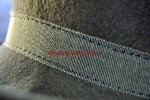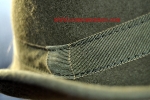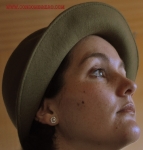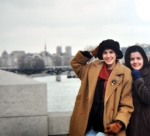 [1]Esta semana hablaremos de un sombrero que marcó toda una época: los locos años 20´. El cloche o campana, era el sombrero de las flappers [2], las chicas que con su vestido corto, sus zapatos de baile y su carmín rojo representan la liberación de la mujer. Su incorporación al mercado laboral le obliga a prescindir de los grandes y fastuosos sombreros de la Belle Epoque, y entre otras cosas, cortarse el cabello a lo garçon. Fuman, bailan hasta el amanecer, se maquillan en público…
[1]Esta semana hablaremos de un sombrero que marcó toda una época: los locos años 20´. El cloche o campana, era el sombrero de las flappers [2], las chicas que con su vestido corto, sus zapatos de baile y su carmín rojo representan la liberación de la mujer. Su incorporación al mercado laboral le obliga a prescindir de los grandes y fastuosos sombreros de la Belle Epoque, y entre otras cosas, cortarse el cabello a lo garçon. Fuman, bailan hasta el amanecer, se maquillan en público…
Pero más allá de esa imagen bucólica, es cierto que ese modelo de sombrero persistió en la calle hasta bien entrados los 30´, y las sombrereras, para ofrecer nuevos sombreros cada temporada, jugaban con la longitud del ala, con los adornos, el material…
Por eso, en las colecciones de sombreros antiguos [3] encontramos una variedad enorme de cloches.
El sombrero de la semana que he elegido es uno que compré en un viaje a París allá por 1992…
He querido fotografiar algunos de los detalles en los que nos fijamos los estudiosos del sombrero para identificarlo. La calidad de este fieltro no es destacable, de grosor fino y pelo corto. En la práctica, ha sabido mantener la forma a pesar de que no siempre ha sido bien almacenado.
La cinta que lo adorna, un grosgrain de algodón, está cosida a máquina, lo que resta estilo al sombrero.
Observemos cómo está cerrada esa cinta: con una vuelta. Si nos fijamos, este típico adorno masculino puede ser un lazo, lazo zapatero, broche…
El ala, reducida y ligeramente volteada. El borde está rematado a máquina.
This week we are going to deal with a hat that denoted an era: the Roaring Twenties. The cloche or bell hat was the Flappers’ hat: girls who represented women’s liberation wearing short dresses with ballet pumps and red lipstick. Their integration into the workplace meant that they had to give up the big and splendid hats of the Belle Epoque and, among other things they had to have their hair cut like a boy (garcon cut). They smoked, danced until dawn, even put their make-up on in public.
Further beyond this bucolic image, there is no doubt that this hat design survived the streets until the 30s, and the milliner’s made alterations to the length of the brim, adornments or materials in order to offer new hat designs each season. Consequently, amongst the antique hat collection we found a great variety of cloches.
The hat of the week I have chosen is one I bought whilst on a trip to Paris in 1992. I took some photos of the details that we, the experts in this field, observe to identify it. The quality of the felt isn’t remarkable; it has short hair and fine thickness. In practice, it has maintained its form although it has not always been well stored.
The Grosgrain ribbon that adorns the hat was made of cotton and sewed by machine, which didn’t make the most of the style of the hat. If we observe closer, paying more attention to detail we can see that the grosgrain ribbon is tied, with a turn up. This typical masculine adornment could be a ribbon, a brooch or a bow. The brim of the hat has been reduced and slightly tilted. The hat rim has been sewn on by machine.
Translated by N.Díaz
Articulos relacionados
La hora del té consombrero [2]
Sombreros de familia para restaurar [10]






1 Comment To "Sombrero de la Semana #3"
#1 Comment By Natalia On 5 febrero 2010 @ 1:14
This week we are going to deal with a hat that denoted an era: the Roaring Twenties. The cloche or bell hat was the Flappers’ hat: girls who represented women’s liberation wearing short dresses with ballet pumps and red lipstick. Their integration into the workplace meant that they had to give up the big and splendid hats of the Belle Epoque and, among other things they had to have their hair cut like a boy (garcon cut). They smoked, danced until dawn, even put their make-up on in public.
Further beyond this bucolic image, there is no doubt that this hat design survived the streets until the 30s, and the milliner’s made alterations to the length of the brim, adornments or materials in order to offer new hat designs each season. Consequently, amongst the antique hat collection we found a great variety of cloches.
The hat of the week I have chosen is one I bought whilst on a trip to Paris in 1992. I took some photos of the details that we, the experts in this field, observe to identify it. The quality of the felt isn’t remarkable; it has short hair and fine thickness. In practice, it has maintained its form although it has not always been well stored.
The Grosgrain ribbon that adorns the hat was made of cotton and sewed by machine, which didn’t make the most of the style of the hat. If we observe closer, paying more attention to detail we can see that the grosgrain ribbon is tied, with a turn up. This typical masculine adornment could be a ribbon, a brooch or a bow. The brim of the hat has been reduced and slightly tilted. The hat rim has been sewn on by machine.
Translated by N.Díaz